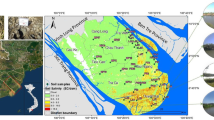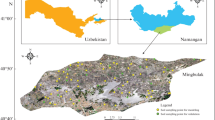Abstract
Soil salinization has increasingly become a serious issue in coastal zone due to global climate changes and human disturbances. Assessment of soil salinity, especially at the landscape scale, is critical to coastal management and restoration. Two data from OLI/TIRS and ETM+ sensors of Landsat satellite were used to compare their ability to invert the spatial pattern of soil salinity in both farmland and salt marsh landscapes in the Yellow River Delta, China, respectively. The results showed that the in situ electrical conductivity (EC a ) of soil, representing soil salinity, were closely related with spectral parameters and salinity indices calculated by the remote sensing data. The results of multiple regression models have showed that nearly all the spectral parameters and salinity indices calculated by OLI/TRIS data were more sensitive to soil salinity than those by ETM+ data. Therefore, the models based on OLI/TIRS data are superior to those on ETM+ data in estimating the spatial pattern of soil salinity in farmland and salt marsh landscapes. Our results were very helpful to evaluate the levels of soil salinization in the Yellow River Delta.





Similar content being viewed by others
References
Abbas A, Khan S, Hussain N, Hanjra MA, Akbar S (2013) Characterizing soil salinity in irrigated agriculture using a remote sensing approach. Phys Chem Earth 55:43–52
Abrol IP, Yadav JSP, Massoud FI (1988) Salt-affected soils and their management. FAO Soils Bulletin 39, Food and Agriculture Organization of the United Nations, Rome
Arnous MO, Green DR (2015) Monitoring and assessing waterlogged and salt-affected areas in the Eastern Nile Delta region, Egypt, using remotely sensed multi-temporal data and GIS. J Coast Res 19(3):369–391
Arnous MO, El-Rayes AE, Green DR (2015) Hydrosalinity and environmental land degradation assessment of the East Nile Delta region, Egypt. J Coast Res 19(4):491–513
Ben-Dor E, Chabrillat S, Dematte JAM, Taylor GR, Hill J, Whiting ML, Sommer S (2009) Using Imaging Spectroscopy to study soil properties. Remote Sens Environ 113:S38–S55
Chavez PS (1996) Image-based atmospheric corrections-revisited and improved. Photogramm Eng Remote Sens 62(9):1025–1035
Chu ZX, Sun XG, Zhai SK, Xu KH (2006) Changing pattern of accretion/erosion of the modern Yellow River (Huanghe) subaerial delta, China: Based on remote sensing images. Mar Geol 1(227):13–30
Cui BS, Yang QC, Yang ZF, Zhang KJ (2009a) Evaluating the ecological performance of wetland restoration in the Yellow River Delta, China. Ecol Eng 35(7):1090–1103
Cui BS, Tang N, Zhao XS, Bai JH (2009b) A management-oriented valuation method to determine ecological water requirement for wetlands in the Yellow River Delta of China. J Nat Conserv 17(3):129–141
Ding JL, Yu DL (2014) Monitoring and evaluating spatial variability of soil salinity in dry and wet seasons in the Werigan–Kuqa Oasis, China, using remote sensing and electromagnetic induction instruments. Geoderma 235:316–322
Dwivedi RS, Kothapalli RV, Singh AN, Metternicht G, Zinck J (2008) Generation of farm level information on salt-affected soils using IKONOS-II multispectral data. Remote Sensing of Soil Salinization: Impact on Land Management. CRC press, Taylor & Francis, Boca Raton 73–90
Fang HL, Liu GH, Kearney M (2005) Georelational analysis of soil type, soil salt content, landform, and land use in the Yellow River Delta, China. Environ Manag 35(1):72–83
Farifteh J, Farshad A, George RJ (2006) Assessing salt-affected soils using remote sensing, solute modelling, and geophysics. Geoderma 130(3):191–206
Farifteh J, Van der Meer FD, Atzberge C, Carranza EJM (2007) Quantitative analysis of salt-affected soil reflectance spectra: A comparison of two adaptive methods (PLSR and ANN). Remote Sens Environ 110(1):59–78
Fernandez-Buces N, Siebe C, Cram S, Palacio JL (2006) Mapping soil salinity using a combined spectral response index for bare soil and vegetation: A case study in the former lake Texcoco, Mexico. J Arid Environ 65(4):644–667
Howari FM, Goodell PC (2008) Characterization of salt-crust build-up and soil salinization in the United Arab Emirates by means of field and remote sensing techniques. Remote Sensing of Soil Salinization: Impact on Land Management. CRC press, Taylor & Francis, Boca Raton, 141–154
Irons JR, Dwyer JL, Barsi JA (2012) The next Landsat satellite: The Landsat Data Continuity Mission. Remote Sens Environ 122:11–21
Khan NM, Rastoskuev VV, Sato Y, Shiozawa S (2005) Assessment of hydrosaline land degradation by using a simple approach of remote sensing indicators. Agric Water Manag 77(1):96–109
Li SN, Wang GX, Deng W, Hu YM, Hu WW (2009) Influence of hydrology process on wetland landscape pattern: A case study in the Yellow River Delta. Ecol Eng 35(12):1719–1726
Liu GH, Ye QH, Liu QS (2003) The dynamic monitoring and digital simulation of ecological environment in Yellow River Delta. Science Press, Beijing
Lobell DB, Asner GP (2002) Moisture effects on soil reflectance. Soil Sci Soc Am J 66(3):722–727
Lu D, Batistella M, Mausel P, Moran E (2007) Mapping and monitoring land degradation risks in the Western Brazilian Amazon using multitemporal Landsat TM/ETM+ images. Land Degrad Dev 18(1):41–54
Mensah KO, FitzGibbon J (2013) Responsiveness of Ada Sea defence project to salt water intrusion associated with sea level rise. J Coast Res 17:75–84
Metternicht G, Zinck JA (1997) Spatial discrimination of salt-and sodium-affected soil surfaces. Int J Remote Sens 18(12):2571–2586
Metternicht GI, Zinck JA (2003) Remote sensing of soil salinity: potentials and constraints. Remote Sens Environ 85(1):1–20
Nawar S, Buddenbaum H, Hill J (2015) Digital mapping of soil properties using multivariate statistical analysis and ASTER data in an arid region. Remote Sens 2(7):1181–1205
Qin DH, Gao M, Wu XQ, Du XY, Bi XL (2015) Seasonal changes in soil TN and SOC in a seawall-reclaimed marsh in the Yellow River Delta, China. J Coast Res 19(1):79–84
Schmid T, Koch M, Gumuzzio J (2008) Applications of hyperspectral imagery to soil salinity mapping. Remote Sensing of Soil Salinization: Impact on Land Management. CRC press, Taylor & Francis, Boca Raton, 113–140
Schofield R, Thomas D, Kirkby MJ (2001) Causal processes of soil salinization in Tunisia, Spain and Hungary. Land Degrad Dev 12(2):163–181
Setia R, Lewis M, Marschner P, Raja Segaran R, Summers D, Chittleborough D (2013) Severity of salinity accurately detected and classified on a paddock scale with high resolution multispectral satellite imagery. Land Degrad Dev 24(4):375–384
Sharma RC, Bhargava GP (1988) Landsat imagery for mapping saline soils and wet lands in north-west India. J Remote Sens 9(1):39–44
Wang FY, Liu RJ, Lin XG, Zhou JM (2004) Arbuscular mycorrhizal status of wild plants in saline–alkaline soils of the Yellow River Delta. Mycorrhiza 14:133–137
Weng YL, Gong P (2006) Soil salinity measurements on the Yellow River Delta. J Nanjing Univ (Nat Sci Edit) 42(6):602–610
Weng YL, Gong P, Zhu ZL (2008) Reflectance spectroscopy for the assessment of soil salt content in soils of the Yellow River Delta of China. Int J Remote Sens 29(19):5511–5531
Whiting ML, Ustin SL (1999) Use of low altitude AVIRIS data for identifying salt affected soil surfaces in Western Fresno County, California. University of California [http://www.cstars.ucdavis.edu/papers/html/whitingetal1999a/paperfr.html]
Wu JW, Vincent B, Yang JZ, Bouarfa S, Vidal A (2008) Remote sensing monitoring of changes in soil Salinity: A case study in Inner Mongolia, China. Sensors 8(11):7035–7049
Xu HQ, Tang F (2013) Analysis of new characteristics of the first Landsat 8 image and their ecoenvironmental significance. Acta Ecol Sin 33(11):3249–3257
Xu XG, Guo HH, Chen XL, Lin HP, Du QI (2002) A multi-scale study on land use and land cover quality change: the case of the Yellow River Delta in China. GeoJournal 56(3):177–183
Yao RJ, Yang J, Liu GM (2008) Application of electromagnetic induction EM38 to rapid analysis of soil salinization in the Yellow River Delta. Agric Res Arid Area 26(1):67–73
Ye QH, Tian GL, Liu GH, Ye JM, Yao X, Liu QS, Lou WG, Wu SG (2004) Tupu methods of spatial-temporal pattern on land use change: a case study in the Yellow River Delta. J Geogr Sci 14(2):131–142
Zhang ZH, Hu CH (2007) Variation of the processes of flow and sediment and its effect on epeirogenesis of seacoast in the Yellow River estuary. Adv Water Sci 18(3):336
Zhang C, Li W, Travis D (2007) Gaps-fill of SLC-off Landsat ETM+ satellite image using a geostatistical approach. Int J Remote Sens 22(28):5103–5122
Zhang F, Tashpolat T, Ding JL, Mamat S, Gui DW (2012) Spectral reflectance characteristics of typical halophytes in the oasis salinization-desert zone on middle reaches of Tarim River, China. Chi J Plant Ecol 36(7):607–617
Zhou D, Lin ZL, Liu LM (2012) Regional land salinization assessment and simulation through cellular automaton-Markov modeling and spatial pattern analysis. Sci Total Environ 439:260–274
Zinck JA, Metternicht G (2008) Soil salinity and salinization hazard. Remote Sensing of Soil Salinization: Impact on Land Management. CRC press, Taylor & Francis, Boca Raton, 3–20
Acknowledgments
This research was funded by the State Key Laboratory of Soil and Sustainable Agriculture, Institute of Soil Science, Chinese Academy of Sciences (Grant No. KZZD-EW-14). The authors also thank the editor and the anonymous reviewers for their valuable comments and suggestions to improve this manuscript.
Author information
Authors and Affiliations
Corresponding author
Rights and permissions
About this article
Cite this article
Meng, L., Zhou, S., Zhang, H. et al. Estimating soil salinity in different landscapes of the Yellow River Delta through Landsat OLI/TIRS and ETM+ Data. J Coast Conserv 20, 271–279 (2016). https://doi.org/10.1007/s11852-016-0437-9
Received:
Revised:
Accepted:
Published:
Issue Date:
DOI: https://doi.org/10.1007/s11852-016-0437-9




